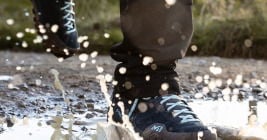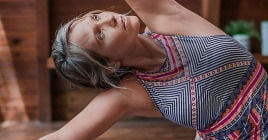.jpg)
What is slackline?
Slacklining first appeared in the USA in the 1980s. At the time, climbers stretched straps between trees and boulders to keep themselves busy and rest their arms on days off or in bad weather. Among other things, this enabled them to recover from their climbing sessions and improve their balance, concentration and sheathing.
The practice gradually spread to the climbing world, but it was only in 2010 that slacklining took off in the media and became a sporting discipline in its own right. Even today, slacklining continues to evolve, with a number of derivatives: jumpline / trickline, with its acrobatic figures; longline, which can span several hundred meters; highline, for those who like high aerobatics; and waterline, for aquatic equilibrists who like to take a dip.
Why slackline?
This helps to develop balance, of course, via the mobilization of several senses such as sight and touch in the feet, but also several organs such as the inner ear, which is the balance processing center. Proprioception is the set of nerve signals transmitted to the brain to regulate posture and body movements - a kind of "sixth sense" in a nutshell.
It's the moment to clear your mind, ignore your surroundings and concentrate solely on the state of flow (or intense concentration). As Eminem attests, this state provokes a sensation of intense well-being and leaves you in absolute control of your body. It trains the brain to concentrate in general, and to select the tasks to be performed while ignoring outside interference.
As with yoga, breathing is fundamental to our balance on the slackline. Deep, regular breathing ensures an efficient supply of oxygen to the muscles and brain, so that they can function at 100% capacity without tensing and shaking. What's more, the benefits of the breathing work involved in slacklining will also be visible in your everyday life.
Slacklining is a shared sport that can be practiced in groups, with friends, indoors or outdoors. It encourages us to push ourselves and our self-confidence to the limit!
.jpg)
How do I choose my slackline?
The slackline can be purchased in kit form, usually including a tree trunk protector, a tensioning ratchet with fastener and webbing.
|
User profile |
Recommended features |
Benefits |
Slackline kit available |
|
For families / with children |
|
|
|
|
Adult beginners for practice close to home |
|
|
|
|
Adults who practice regularly and need to carry their equipment with them wherever they go. |
|
|
DID YOU KNOW?
 |
The instability of a slackline depends on its length, elasticity and weight:
|
Where to set up your slackline?
Please take care to protect our green friends!
It's also possible to fix a slackline to a wall, or even directly into the ground, without trees - special kits are available for this purpose. It can also be installed between fixed rocks.
Be careful not to attach a slackline to urban infrastructure! The tension exerted by the strap can cause serious damage and put you in danger. It's also advisable not to stretch your slackline across a path or passageway.
If you're looking for good slackline spots, there are many groups on social networks to list them, and several websites can also show you spots via an interactive map. The community spirit of this sport will enable you to meet new people and develop your own slacklining network!
How do I set up a slackline?
⚠️Toujours do a back-up to secure your tensioning system, especially on ratchet or pulley systems. If a component breaks, there's a risk of projection and injury. Backing up can prevent this.
Several back-up techniques exist, and there's always a way to find a way of doing a back-up with what you have on hand (excess webbing or a piece of rope attached to the webbing).

Let's set up the slackline: there are two lanyards: a small one and a large one. Start with the small one and work your way around the tree WITHOUT TAKING A TURN, otherwise you risk damaging your strap (remember to position your tree trunk protector or a piece of cardboard if you don't have one). This little lanyard has a ratchet and a buckle. Pass the ratchet through the buckle, and point the handle downwards. Remember to keep your lanyard flat as you pass it through the buckle; you can pinch your lanyard slightly inwards for better positioning.
Then repeat the same procedure with the long lanyard (go around the trunk and pass it through the loop), keeping the strap flat. Then unwind to join the two ends.
For the final step, pass the strap through the pawl, keeping the handle pointing downwards, then pull the strap taut with one hand and tighten the pawl with the other. In general, 3 strokes are enough to tension the strap correctly. Once the slackline is securely in place, remember to lock the ratchet and put a back up. Now all you have to do is go for it!
To dismantle your slackline, unlock the pawl by opening the jaw as far as it will go and pressing down on the handle. Remember to put your slackline away neatly at the end of your sessions!

How to progress on a slackline: a few tips
Place your strong foot on the strap, keep your arms parallel to the ground, your back straight, take a deep breath and push on your second foot behind the first. It's essential to focus on a distant point ahead.
Then put all your weight on the front foot to swing your second leg forward for your first step, always looking ahead. First your toes touch the strap, then your heel, and finally shift your weight onto your leg. Remember to breathe! This will prevent shaking and increase your concentration. Now it's your turn!


.jpg)











